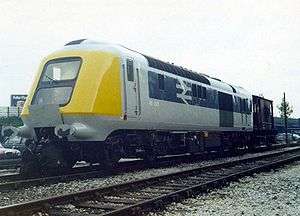British Rail Class 41 (HST)
| British Rail Class 41 (HST) | |||||||||||||||||||||||||||||||||
|---|---|---|---|---|---|---|---|---|---|---|---|---|---|---|---|---|---|---|---|---|---|---|---|---|---|---|---|---|---|---|---|---|---|
|
41001 is inspected after arrival at RTC Derby in 1972 | |||||||||||||||||||||||||||||||||
| |||||||||||||||||||||||||||||||||
| |||||||||||||||||||||||||||||||||
| |||||||||||||||||||||||||||||||||
| |||||||||||||||||||||||||||||||||

The British Rail Class 41 was the original classification for the power cars of the prototype High Speed Train (HST) of 1972. The HST was later re-classified as a diesel-electric multiple unit, and the whole set became Class 252. They were of Bo-Bo wheel arrangement.
Two power cars were built, 41001 and 41002. After the Class 252 re-classification these were renumbered into the carriage numbering range as 43000 and 43001.
As of 2015 41001 is operational and based at Ruddington Park MPD, on the Great Central Railway (Nottingham) as part of the National Collection owned by the National Railway Museum (NRM) in York. It is registered as 43000 to allow for positioning moves via the Network Rail network. In December 1990, the second power car 41002 was scrapped at C F Booth, Rotherham. Both were allocated to Headquarters (HQ).
Restoration
Plans were announced in May 2011 to return 41001 to service by the 125 Group, under the banner of Project Miller (named for Terry Miller, formerly Chief Engineer (Traction & Rolling Stock) for British Rail), who took the power car on long term loan to complete the work required.[3] On 29 March 2012 41001 was hauled from the NRM York to East Midlands Trains' Neville Hill Depot in Leeds by Devon & Cornwall Railways' Class 31 31601, its first main line outing since 1985. The 125 Group, under the banner of Project Miller, completed the work to return it to running order. As part of this move, it was re-registered as Class 43/9 locomotive 43000.[4]
41001 was one of the attractions at the NRM's "Railfest" event in June 2012.[5] On 31 May 2014, the locomotive completed a loaded test run along a section of the Great Central Railway, hauling two British Railways Mark 2 carriages and a Class 56 locomotive.[6]
On 15 November 2014, 41001 hauled its first passenger train since 1976, a special named "Screaming Valenta".[7] A short-formed East Midlands HST set left Derby at around 10:30am bound for Loughborough Junction before reversing and travelling up the Great Central Railway to Ruddington Fields. Once at Ruddington, the leading power car was uncoupled and 41001 substituted. The train then reversed to 50 Steps, where another reversal took place. 41001 then hauled the train back to Loughborough Junction where the train reversed again and returned to Ruddington via 50 Steps.
Once back at Ruddington, 41001 was uncoupled and the East Midlands power car replaced. The special train then ran back onto the main line at Loughborough Junction, running via Leicester and then back to Derby.
Great Central Railway (Nottingham)
As of 2015 41001 has been based at the Great Central Railway (Nottingham) in Ruddington, where it normally works the preserved section top and tail with Class 56 number 56097, and a rake of coaches consisting of three British Rail Mark 3 carriages belonging to the 125 Group, and a British Rail Mark 2 carriage belonging to the preserved railway. The formation is normally hauled with 56097 hauling to the reversal at Fifty Steps, then 41001 hauling southwards to Loughborough Viaduct. On the return trip 56097 will lead to Fifty Steps then 41001 takes power for the final trip back to Ruddington.
References
- ↑ Haresnape, Brian (June 1983). British Rail Fleet Survey 5: High Speed Trains. Shepperton: Ian Allan. p. 41. ISBN 0-7110-1297-0. GE/0683.
- ↑ Maclean, Stuart (4 June 2014). "NRM HST prototype 41001". National Preservation. Retrieved 25 November 2015.
has its original 110V/1000V Auxiliary Alternator fitted so isn't compatible with production HST electronics. … standard DC ETH rather than the 415V AC of an HST so more useful for a role on preserved railways. … not being able to provide train supply to an HST set,
- ↑ Project Miller (12 May 2011). "(untitled)" (Press release).
- ↑ Heelas, Gary (13 June 2012). "Power trip". RAIL (698): 44–47.
- ↑ "Railfest 2012 souvenir prochure". Bauer Media. 2–10 June 2012: 26.
- ↑ 41001 Returns!
- ↑ "In Brief". Rail Express (224): 36. January 2015. ISSN 1362-234X.
External links
| Wikimedia Commons has media related to British Rail Class 41. |
